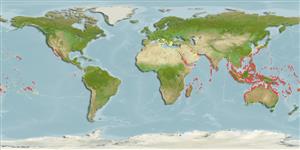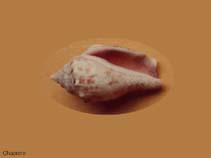Strombus mutabilis Swainson, 1821
Mutable conch| Native range | All suitable habitat | Point map | Year 2050 |

|
| This map was computer-generated and has not yet been reviewed. |
| Strombus mutabilis AquaMaps Data sources: GBIF OBIS |
Classification / Names Common names | Synonyms | CoL | ITIS | WoRMS
Gastropoda | Littorinimorpha | Strombidae
Environment: milieu / climate zone / depth range / distribution range Ecology
Benthic; depth range 0 - 20 m (Ref. 349). Tropical
Distribution Countries | FAO areas | Ecosystems | Occurrences | Introductions
Indo-Pacific and the Mediterranean Sea.
Length at first maturity / Size / Weight / Age
Maturity: Lm ? range ? - ? cm Max length : 4.0 cm SHL male/unsexed; (Ref. 349); common length : 3.5 cm SHL male/unsexed; (Ref. 349)
Shell used in shellcraft (Ref. 349). Abundant in rocky reefs, either in exposed or in protected areas and in clear to turbid waters. Most common just below the low tide marks. Members of the family Strombidae are mostly herbivores , browsing on delicate algae, or swallowing sand and detritus to digest the decomposing plant matter (Ref. 349).
Life cycle and mating behavior Maturity | Reproduction | Spawning | Eggs | Fecundity | Larvae
Members of the order Neotaenioglossa are mostly gonochoric and broadcast spawners. Life cycle: Embryos develop into planktonic trocophore larvae and later into juvenile veligers before becoming fully grown adults.
Main reference
References | Coordinator | Collaborators
Poutiers, J.M. 1998. (Ref. 349)
IUCN Red List Status (Ref. 130435)
CITES status (Ref. 108899)
Not Evaluated
CMS (Ref. 116361)
Not Evaluated
Threat to humans
Harmless
Human uses
| FishSource |
Tools
More information
Internet sources
BHL | BOLD Systems | CISTI | DiscoverLife | FAO(Publication : search) | Fishipedia | GenBank (genome, nucleotide) | GloBI | Gomexsi | Google Books | Google Scholar | Google | PubMed | Tree of Life | Wikipedia (Go, Search) | Zoological Record
Estimates based on models
Preferred temperature
(Ref. 115969): 22.7 - 29.2, mean 28.3 (based on 3612 cells).



